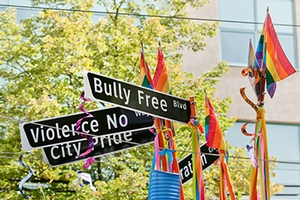Research
What is the Impact of Bullying on Lesbian, Gay, and Bisexual Students?

Bullying presents a critical issue for educators, given its negative repercussions for both the direct victims and the overall school climate. A growing issue is that lesbian, gay, bisexual (LGB) students experience a disproportionate amount of bullying.
SPA Professor Lynn Addington used data from the 2015 National Crime Victimization Survey's School Crime Supplement to explore the direct impact of bullying on 12- to 18-year-old students of different sexual orientations. Her paper, "What is the Effect of Being Bullied? Comparing Direct Harms of Bullying Experienced by LGB and non-LGB Students," appeared in the Journal of Family Strengths in December.
The study results confirm that students who were bullied because of their sexual orientation reported more frequent bullying than students who did not attribute the bullying to their sexual orientation. More than half of the sample of LGB bullying victims experienced bullying more than once a month, and almost one-third as more than once a week. In contrast, about a third of non-LGB victims experienced bullying more than once a month. Due to data limitations, bullying based on gender identity or being transgender was not included in the analyses.
Although the differences between the two groups were not statistically significant, the patterns for LGB bullying victims indicate that more than half were bullied in spaces where supervision could have been provided (such as a hallway) or should have been present (such as a classroom). Among both LGB and non-LGB bullying victims, fewer than half indicated that they had told a teacher or other adult at school about their bullying experiences.
Addington says the new contribution of her study is its focus on the direct consequences of being bullied. Previous research mainly examined indirect effect of bullying. Of particular interest are her findings on the direct effects bullying has on self-esteem. LGB students were more likely to say that bullying had a negative effect on feelings they had about themselves to some degree. Conversely, non-LGB students most frequently indicated that the bullying had no effect on their self-esteem. Similar patterns were observed for the effect on LGB victims' schoolwork or relationships with family and friends.
Although her study was preliminary and used a small sample, Addington says the findings provide information for future researchers to examine the repercussions on LGB students' self-esteem, especially regarding the direct harms of bullying. The findings also suggest the need for administrators and counselors to understand the unique experiences of LGB bullying victims.
"This study supports the current work occurring in school districts across the country to create safe learning environments, and it highlights the need for these positive school climates to be inclusive ones," says Addington. "Preventing bullying is one aspect of promoting inclusion, especially bullying targeting LGB students. When bullying is negatively affecting these students' self-esteem and schoolwork, it likely hinders their ability to be fully involved in the school community."
